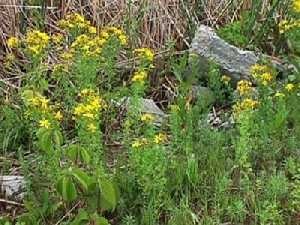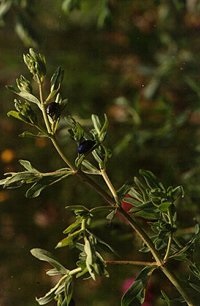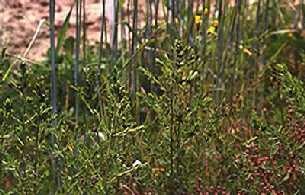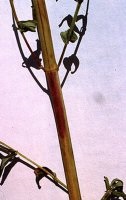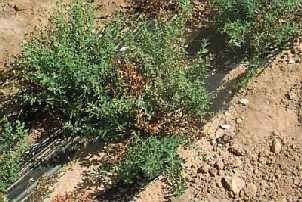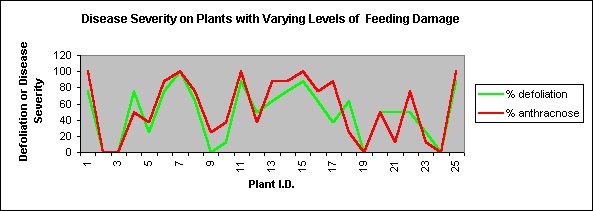St. John’s Wort and Chrysolina spp. Beetles
Learn about St. John’s Wort and options for biological control.
Introduction
St. John's wort has long been a magical plant in folklore. In medieval times it was believed that if you stepped on the plant after dark you would be transported by a magical horse around the heavens and returned to earth only as the sun rose. It was universally called "the Grace of God". In England it was used to cure insanity, in Russia to cure rabies and in Brazil as a cure for snake bite. Crushed flowers oozed a red pigment (hypericin) that looked like blood. Its name derives from the fact that its flowers are harvested around the summer solstice or St. John's day on the 24th of June. It is extremely attractive to cats and rats and is said to have been used by the Pied Piper to lure rats out of Hamelin. Unfortunately, it is also attractive to certain Chrysolina spp. beetles.
Today St. John's wort is one of the most popular medicinal plants. It is used extensively in Europe in the treatment of mild depression. It also has antiviral and antibacterial properties and is used to promote the healing of damaged nerves.
The chemical most often connected with St. John's wort is hypericin, the chemical used as a "marker" for medicinal activity. Recent research has revealed that there are at least 50 chemicals in this plant with varied medicinal properties. Like so many plants that are used as medicines the valuable properties of this herb cannot be attributed to one single chemical.
St. John's wort, however, is more than an important medicinal. It is a serious noxious weed on grazing lands in parts of North America. Since many animals grazing on St. John's wort react to hypericin, this weed was the subject of one of the first successful programs in weed biocontrol.
Chrysolina beetles
St. John's wort, a native of Europe, was first introduced to North America in 1793 in Pennsylvania. It became established in Eastern Canada by 1883. Over much of its range in Canada it has been successfully controlled by the introduction of insects that feed only on St. John's wort. Biological control of St. John's wort was introduced in Australia in the 1930's with the introduction of three beetles that fed only on St. John's wort in its native habitat in Europe — Chrysolina hyperici from the Atlantic region of Europe; C. quadrigemina from the Mediterranean region and Anaitis plagiata from northern Europe. During the 1950's Ontario imported and released all three species in an effort to achieve similar biological control of St. John's wort. C. quadrigemina is currently predominant.
Description
Chrysolina quadrigemina is a member of the Chrysomelidae, the same insect family that contains the Colorado potato beetle. Its shape and habits are similar to those of this common and destructive pest of solanaceaous plants. When disturbed, Chrysolina spp. beetles will drop from the plant and "play dead" on the soil. They feed voraciously both as larvae and adults.
There are four colour morphs of this beetle, bronze, metallic green and metallic blue, and a purple form not recently observed in Ontario. Bronze coloured beetles outnumber blue coloured beetles by about 9:1. Green coloured C. quadrigemmina are rarely found. The metallic sheen on their elytra (wing covers) is distinctive.
Damage
Defoliation is most severe in the week before flowering and continues during maximum bloom, the time when flowers are harvested for medicinal use. In observation plots of 3-year-old St. John's wort as many as 97 beetles per plant were counted. The beetles fed mostly on the leaves, and flower tops were left relatively untouched.
Life cycle
Chrysolina spp. are leaf-feeding beetles. In other jurisdictions, the insects over-winter as eggs that hatch early in the spring. In Ontario, it is unknown whether the beetles over-winter as larvae or eggs. Larvae resemble those of the Colorado potato beetle. Research has shown that both the larvae and adults accumulate hypericin that they ingest from the plants. The amount of hypericin in the larvae is enough to make them photosensitive and feeding habits seem to reflect this accumulation.
Very young larvae feed only at night and are concealed in terminal leaf buds during the hours of peak sunlight. Older larvae feed only in the early dawn. They burrow into the soil during the day and remain there until dawn the next day. Mature larvae pupate in the soil. Adults emerge from the soil about the first week of June. Adults feed heavily until mid-late July. The elytra (protective wing covers) transmit almost no light and thus the hypericin cannot become "activated". Adults are reluctant to fly from plant to plant. When the elytra are opened during flight, light can penetrate the cuticle, activating the hypericin which becomes toxic to them. Adults move about only when threatened with starvation.
In mid–late July the adult beetles enter summer diapause, burrowing into the soil to "rest" until they are ready to emerge to mate and lay eggs. In demonstration plots, no mating activity was observed among the adults during early season feeding. This type of diapause is very risky for the beetles. By mid-August 80% of the beetles in the ground had succumbed to predation in the demonstration plots. The most prevalent predatory beetles are in the Carabidae family.
The link to Anthracnose
In a survey of 11 different sites in Ontario, 100% of the sites showed signs of anthracnose infection. Preliminary identification of Colletotrichum gloeosporioides was made from isolates from stem lesions. This disease is endemic in the Nova Scotia where researchers noted that the disease was spread by Chrysolina spp. beetles. In addition, when stem lesions were combined with defoliation by beetles, the plants suffered 75% winter kill.
At wild sites in Ontario beetles were found only occasionally and anthracnose at low levels did not cause severe dieback of the stems. The situation was much different in cultivated plantings of St. John's wort.
Anthracnose was prevalent in most cultivated plantings of St. John's wort. Anthracnose lesions on cultivated plants expanded until they girdled the stem and the entire plant was involved. The disease progressed to involve entire plants. The disease progressed quicker on plants transplanted into plastic mulch. Unless totally diseased, for the first two years plants succumbing to anthracnose re-grew the following spring. Commercial growers found that these plants could be harvested for the flowers but the overall harvest weight was reduced.
Colletotrichum can be a seed-borne disease. Producers growing their own transplants should take care to obtain disease-free seed.
The relationship between Chrysolina spp. beetles and anthracnose on St. John's wort
Two factors are at work in cultivated St. John's wort that threaten the survival of the plants:
- beetle populations can be very high by the 3rd year of cultivation
- disease can be introduced on the seed resulting in higher disease incidence than in wild stands.
This combination of beetles and disease results in considerably more damage to the planting than either pest alone. In recent studies there was a direct link between the severity of feeding damage and the severity of disease.
References
- Campbell C.L. and J.P. McCaffrey. 1991. Population Trends, Seasonal Phenology, and Impact of Chrysolina quadrigemmina, C. hyperici(Coleoptera: Chrysomelidae), and Agrilus hyperici (Coleoptera: Buprestidae) Associated with Hypericum perforatum in Northern Idaho. Environ. Entomol. 20(1): 303-315
- Duffey S.S. and J.M. Pasteels. 1993. Transient uptake of hypericin by chrysomelids is regulated by feeding behaviour. Physiological Entomology 20, 119-129
- Fields P.G., John T. Aenason and Bernard J.R. Philogene. 1989. Behavioural and physical adaptations of three insects that feed on the phytotoxic plant Hypericum perforatum. Can. J. Zool. 68: 339-346
- Hildebrand P.D. and K.I.N. Jensen. 1991. Potential for the biological control of St. John's-wort (Hypericum perforatum) with an endemic strain of Colletotrichum gloeosporioides. Can J. Plant Pathol. 13: 60-70
- Morrison Kimberley D., Edward G.Reekie and Klaus I.N. Jensen. 1998. Biocontrol of common St. John'swort (Hypericum perforatum) with Chrysolina hyperici and a Host-Specific Colletotrichum gloeosporioides. Weed Technol. 12: 426-435
This info sheet was originally authored by Jan Schooley, former Ginseng and Medicinal Herb Specialist, OMAFRA.
